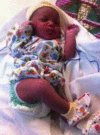IVF in Africa: what is it all about?
- PMID: 31695859
- PMCID: PMC6822948
IVF in Africa: what is it all about?
Abstract
Infertility is a universal problem with the highest prevalence in low-resource countries, particularly in sub-Saharan Africa where infection-related tubal damage is the commonest cause. It is estimated that more than 180 million couples in developing countries suffer from primary or secondary infertility. In most African countries, the social stigma of childlessness still leads to isolation and abandonment. Differences between the developed and developing world are emerging because of the different availability in infertility care and the different socio-cultural value surrounding procreation and childlessness. Although reproductive health education and prevention of infertility are number one priorities, the need for accessible diagnostic procedures and affordable assisted reproductive technologies (ART) is very high. The success and sustainability of ART in resource-poor settings will depend, to a large extend, on our ability to optimise these techniques in terms of availability, affordability and effectiveness. Different new innovations and techniques can make the diagnostic work-up and treatment through assisted reproductive technologies (ART), including in-vitro fertilization (IVF), more affordable. These include automated smartphone-based assays for semen analysis and simplified IVF culture systems. The initiative of African Network and Registry for Assisted Reproductive Technology (ANARA) to register all IVF cycles in Africa needs our support and will be of paramount importance in the future. The hurdles to implement ART in most African countries are numerous and although more and more IVF centres are founded, the accessibility to ART remains very low.
Keywords: ART; Africa; IVF; accessible; affordable; assisted reproductive technologies; childlessness; developing countries; infertility.
Copyright © 2019 Facts, Views & Vision.
Figures










References
-
- Adamson GD, DeMouzon J, Dyer S, et al. ICMART world report 2013. Hum Reprod. 2017;32(Supplement 1):(i64-i65)
-
- Agarwal A, Panner Selvam MK, et al. Home sperm testing device versus laboratory sperm quality analyzer: comparison of motile sperm concentration. Fertil Steril. 2018;110:1277–1284. - PubMed
-
- Boivin J, Bunting L, Collins JA, et al. International estimates of infertility prevalence and treatment-seeking: potential need and demand for infertility medical care. Hum Reprod. 2007;22:1506–1512. - PubMed
LinkOut - more resources
Full Text Sources
